10 Social Listening Tools and Who They’re Best for
By BrandwatchJul 14
Join us and boost your social media potential with our data-led event
Published June 29th 2016
Why is it difficult to gain social media engagement? The sheer scale of the competing voices is undoubtedly one factor; every single day 2.5 billion new items of content are shared on Facebook alone. To stand out from a crowd of that size you really need to offer something of value.
Does social media engagement actually matter? Isn’t it all a vanity exercise? Ultimately, engagement spreads your content further, rippling out through natural networks. Engagement is not about patting yourself on the back as the numbers roll in, but building an ever increasing network of followers and fans who will see your content. Ultimately this should help attract new customers.
Content needs to provide value to engage with people. It needs to be genuinely useful, interesting, inspiring, curious, funny or otherwise engaging in some real way. Then there is the psychology of social content to consider.
While creating engagement-worthy content will still take ingenuity and imagination, experience has shown that you can create a framework around your content that will help to gain social media engagement.
Different forms of engagement create different actions. If you want to drive brand awareness, retweets and shares will put your content in front of people who might not have seen it otherwise. Gaining followers is great for the long term, as more people will be presented with your content and can help spread it further.
Decide on what it is you are trying to achieve, and the corresponding metrics that will demonstrate improvements in that area.

Different activities and different content are likely to drive different types of engagement. For example, a Twitter chat can be useful for increasing your followers, as each person who joins the chat will spread the conversation, and you should have an interesting discussion for the new audience to join. A chat is also a great way to engage your existing community.
Once you have decided what it is you are setting out to achieve, you can tailor your campaign towards that particular goal.
Your audience is made up of real people, with a variety of interests outside of your brand. That’s an obvious point, but one many brands seem to forget. By understanding what those interests are, you can add more value.
Social analytics tools can provide this information by examining the topics your audience are talking about.
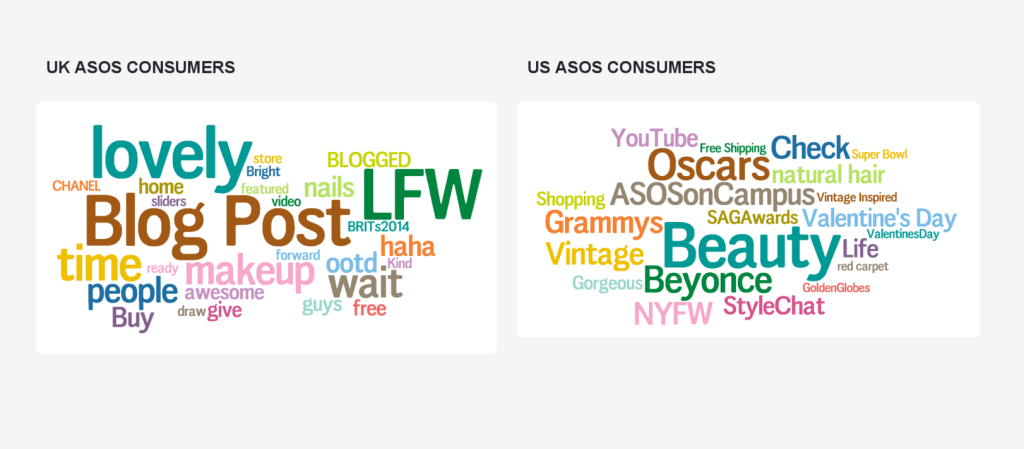
In addition to helping you refine your own messaging, sharing content from other sources is a useful tactic. A non-stop barrage of self-promotion is a real turn-off for most.
Sharing relevant content from other sources will break up the branded content and show that you are considering your audience. Recognising that value can be provided by organizations and people other than yourself shows you are not simply there for the hard sell.
A fact often repeated and backed up by research, pictures and video are the most engaging forms of content. However, visual content is not a fix-all, and still needs to be well crafted.
At the very minimum, make sure you get the dimensions correct. Each site has different picture sizes, and several guides on picture dimensions will ensure you get this simple point right.
In addition to visual content, there are other tactics that are often quoted to increase engagement on social media:
A popular tactic is to make a retweet of your message the entry to the competition. This gives people an incentive to retweet, putting the competition in front of a much wider audience. Honda grew their social buzz by a staggering 1221% during a one-month competition using this tactic.
Hashtags can help people find your content, but overuse of hashtags is seen as bad practice. Highjacking a popular hashtag is only practiced by spammers and bots, and should definitely be avoided.
While these techniques can definitely work, none of them offer a guarantee of engagement. You still have to offer value, be that relevancy, helpfulness, humor, and so on. It doesn’t look great to ask a question nobody answers or have a poll that hardly anyone votes on.
Do you like using Twitter polls for increasing engagement? #SocialMedia
— Communications Axis (@CommsAxis) November 19, 2015
The best time to post will depend on several factors. Your location, a national or international focus, the industry you operate in and the platform you are publishing to will all play a part.
The best way to establish when you should post is by looking at your own analytics, whether that’s an integrated tool like Facebook Insights or a dedicated social analytics tool. This is going to give you the best, most personalized data on when to post.
With Brandwatch, you can compare your activity to the audience activity by days of the week, or hours of the day. This gives you data about your specific audience and allows you to make sure you are active at the same time as them.
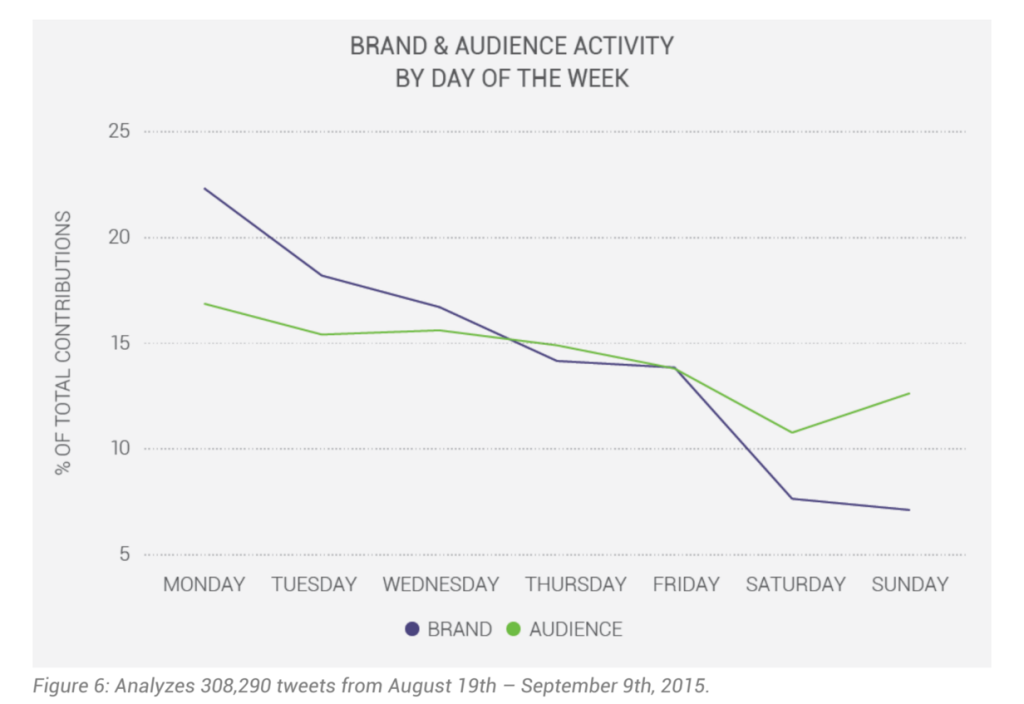
There are also several studies that have examined the best times to post on average. These generally examine thousands or millions of posts across a wide range of industries, and can be useful if you lack your own analytics.
SumAll has collated several online studies into two handy infographics, one detailing when to post and one when not to post.
Should you be on every social media site out there? You want to be accessible to your audience, and that may well involve being on more than one network. However, it is important not to spread yourself too thin, as responding quickly is vital for engagement (more on that later).
Think about which platforms are best for your business. B2B companies will generally find a larger and more engaged audience on LinkedIn than Snapchat, for example.
In some cases, it can be useful to create multiple accounts on the same platform. Many companies have a main account and a customer service channel: a useful split that keeps primary messaging separated from customer issues.
Nike has 46 verified Twitter accounts, which may make sense for a brand of that size but would be overkill for many businesses. It is important to not confuse customers and fragment your voice too much.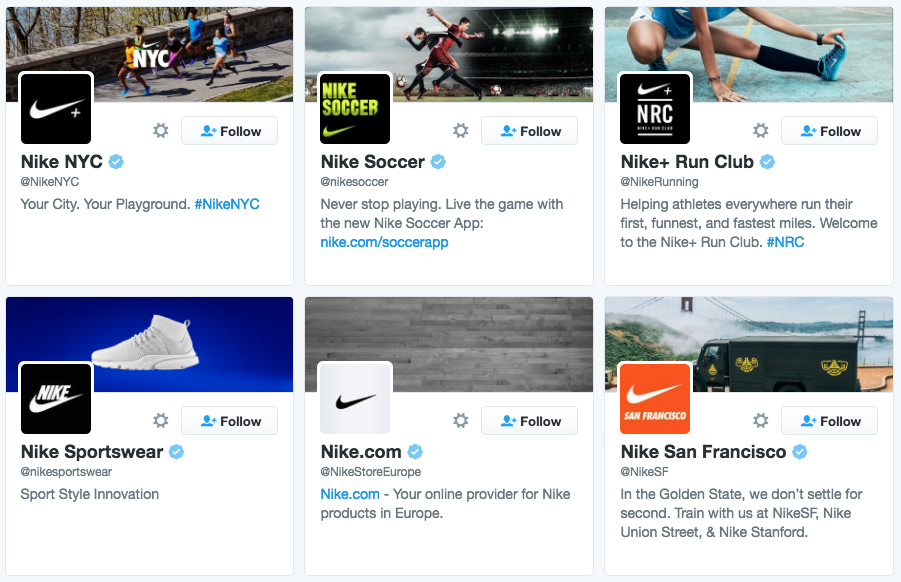
Some segmentation of accounts can make sense. You may be releasing different types of content aimed at different segments of your audience. By grouping everything together you can create a lack of cohesion, where too much irrelevant information detracts from the useful stuff. This can lead to a lack of engagement and crucially, a declining number of followers.
This is vitally important. People contact businesses on the platform of their choosing, and they expect a quick response. We’ve previously covered using customer service as a marketing tool, and it can be a powerful tactic.
In one study, customers who received replies to Tweets were more satisfied with their experience, more willing to recommend the company, and willing to pay more in the future.
Responding to customers shouldn’t just be about dealing with customer complaints. Part of earning engagement from your audience means – surprise – engaging with them.
When customers or prospects interact with your brand, responding in a timely manner is the polite, human thing to do. NikeRunning’s Twitter is a great example of this, constantly engaging with their audience in an affirming way, creating a giant community of like-minded people.
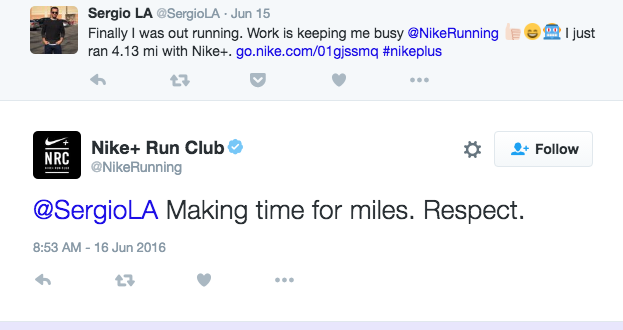
There are a number of tools that can help with social media engagement in a variety of ways, from improved content to making sharing easier.
Spruce – Improve your engagement by creating shareworthy photos overlaid with text. Type your text, choose from thousands of public photos or upload your own, and post directly to Twitter or Facebook. Free to use.
Canva – Simple to use online design software, that features social media templates. It’s free to use, so you can easily create better images for your social channels.
Click To Tweet – Provides a link so readers can easily tweet a quote direct from your content, encouraging higher engagement. Simple to use and provides tracking and analytics.
Digg Digg – A WordPress plugin made by Buffer, which adds sharing buttons with counts on your page. Networks covered include Twitter, Buffer, Facebook Share, Facebook Like, Digg, LinkedIn, Google+.
HowSociable – Add your social media accounts, or that of your competitors, to receive a score for each platform based on that week’s usage.
Of course, you need to track your efforts to see what is working and what isn’t. There should always be an element of experimentation, and by keeping a careful eye on the numbers you can repeat what is working and stop what isn’t.
What should you be measuring? This depends largely on the goals that were set at the start. Brandwatch tracks a variety of metrics so you can understand which tactics have been most successful. The following metrics are some of the measurements to consider.
Followers – the people who will be regularly exposed to your posts and content. The more followers you have, the further your reach will be
Shares/RTs – how many times your content is shared by others, increasing its reach
Mentions – how many times is your brand mentioned tweets or posts
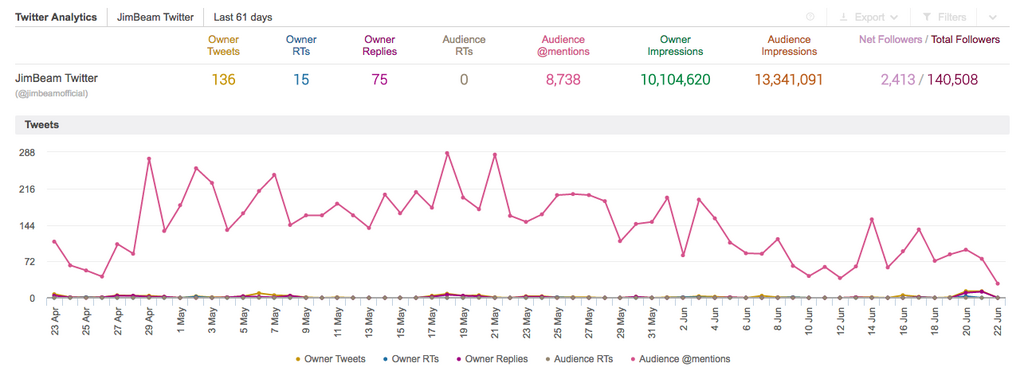
Comments – the number of comments posted in response to your post
Likes – probably the least valuable engagement metric as it’s easy to give away. People can often hit the like button without reading the full story or really engaging with it
Reach – the number of individuals who have actually seen your content
Impressions – the potential number of times your content was seen (not the number of times it was actually seen). This could include the same person seeing it twice if it reappears in their timeline/feed
Sentiment – when tracking online conversations, social intelligence tools use natural language processing to segment negative and positive statements
Share of Voice – by tracking the social conversation around your brand and your competitors, you can understand the percentage of conversation focused on your brand
Traffic – Ultimately, all this engagement should be driving people to your site. Your web analytics program will be able to tell you how many people have arrived at your site via social media
Earning social media engagement is about connecting with people, and offering them valuable content. Setting your goals and knowing your audience are key to success. Alongside these tenants, some simple research can help you maximize your efforts.
Finally, the only way to know what is working and what isn’t is to track your metrics. Continually monitoring the numbers means you can amend your strategy based on the results, and keep improving your social media engagement.
Offering up analysis and data on everything from the events of the day to the latest consumer trends. Subscribe to keep your finger on the world’s pulse.
Existing customer?Log in to access your existing Falcon products and data via the login menu on the top right of the page.New customer?You'll find the former Falcon products under 'Social Media Management' if you go to 'Our Suite' in the navigation.
Brandwatch acquired Paladin in March 2022. It's now called Influence, which is part of Brandwatch's Social Media Management solution.Want to access your Paladin account?Use the login menu at the top right corner.